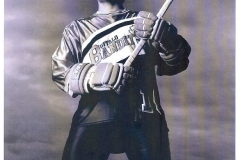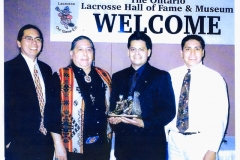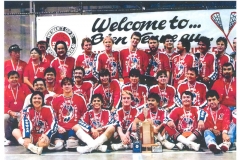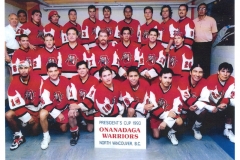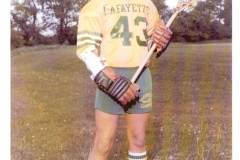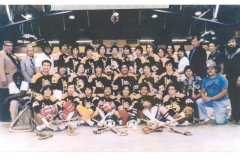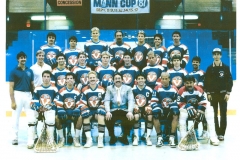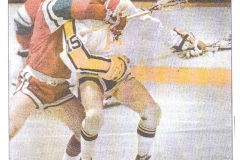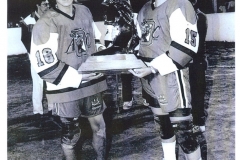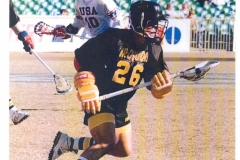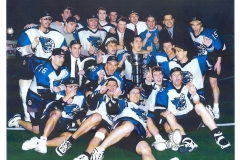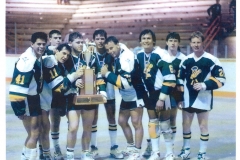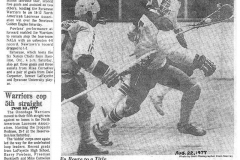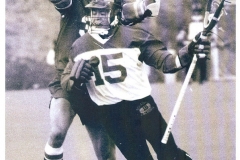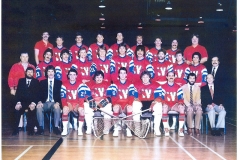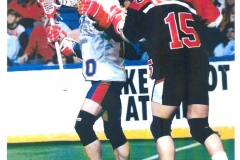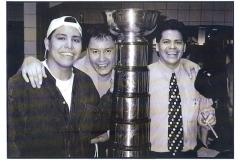Barry Powless of the Onondaga Nation is featured as one of the outstanding Haudenosaunee lacrosse players. Barry was an All-American atttackman at LaFayette HS and later the first alumni Head Coach, winning lacrosse titles as an Onondaga Warrior/Redhawk, a North Shore Indian, a Furgus Thistle, a New Westminster Salmonbellie, a Tuscarora Arrow, a Vancouver Adnac and professional titles with the Buffalo Bandits and and as a Head Coach of the Rochester Knighthawks.
The 1999 Canadian Hall of Fame Inductee recounts some of his lacrosse tales in a book published by the North American Traveling College. To order the $20 book Contact Russel Poundpoint at Tel 613-932-9452 ext 224 or roundpoint@ronathahonni.com.
The Powless Family
Onondaga Nation
Lacrosse fans in Canada and the United States will remember Barry Powless as one of the greatest lacrosse players in recent history to come from the Onondaga Nation, but he would tell you that he is just part of a long line of lacrosse players that represented the Powless family over the past century.
His great grandfather, grandfather and father were all lacrosse players that played for the Onondaga Nation teams and represented their people through many generations of lacrosse. Welcome Powless played for Onondaga during the 1900s up to the 1930s and was an active player until he was well into his sixties.
His son Irving Powless Sr. was a star player not only for Onondaga, but for the Syracuse Red Devils and for the Rochester Senecas during the 1930s and “40s” era. He was one of the players who made an all-star Native lacrosse team that was assembled to challenge for the right to represent the United States at the 1932 Olympics in Los Angeles when the game of lacrosse was featured as a demonstration sport.
The game itself was changing at this time when box lacrosse was introduced as a new sport and moved to indoor arenas whenever the hockey season ended. Soon after, a new box league emerged in Central N.Y. that featured a brand new game of lacrosse, and Irving Powless Sr. was one of the stars.
His son Irving Powless Jr. was also one of the better players on the Onondaga team throughout the fifties and sixties. The Onondagas lacrosse senior teams could always hold their own against the best teams from the Seneca, Six Nations and Mohawk reservations. They routinely held bragging rights in competitions with the other Iroquois communities because they were the smallest in population but were always the most competitive.
The most interesting lacrosse story to share is, ironically is not about Barry but his grandfather Irving Powless Sr. As a child, Barry had the opportunity to sit around many camp fires and listen to his Elders recall many stories of their finest lacrosse days. He had no idea how well regarded his grandfather was as a lacrosse player until he listened to other Elders share their stories about the ‘golden days of lacrosse’ and the part his grandfather had played in them.
This is their story as retold by Barry Powless …
Teiontsikwaeks
My Grandfather – Irving Powless Sr. (1905-1985)
By Barry Powless
Irving Powless Sr., lived from 1905-1985 and was a lifelong resident of the Onondaga Nation. In addition to excelling at lacrosse he was also a speaker in the longhouse and helped to preserve the traditional way of life at Onondaga. He played with Onondaga field and box lacrosse teams during the 1920-40s. He played against other Haudenosaunee communities, local colleges in the area such as Syracuse, Cornell, Colgate, Cortland and Hobart and played professionally. He also coached the Onondaga field and box lacrosse teams after his playing days were over.
Irving played pro lacrosse and was a star player for the Syracuse Red Devils and Rochester Senecas during the 1930s. The Championship of that league was called the Ziegler Cup and he played on one of the championship teams during that time. He said the players in the pro-league were compensated more per game than the players in the pro baseball league during that time. He was well known for his play making abilities and for his defense, especially the hip check. He used to tell of how well padded the players were during the days he played professionally compared to the homemade pads that he wore before and after playing professional lacrosse. He would tell that it was like wearing a suit of armor. The pads they wore completely covered their arms, back, and ribs.
He recalled one occasion when the Syracuse owner came into the locker room before the game and announced that the player with the most goals for that game would receive a steak dinner. Also sitting in the locker room were his friends and teammates Stanley and Lyle Pierce from Onondaga. Both Pierce brothers were top goal scorers on the team. Irving and Lyle worked especially well together on the floor as he would always look to set up Lyle for the shot on goal.
That night as he told the story was different. Instead of passing the ball to the Pierce brothers, as most teams anticipated he would do, he faked the pass and shot the ball himself at the goal. He then stated with a smile and chuckle, “Boy that steak sure was good,” as he scored six goals that evening.
One of the defensive maneuvers used during that time was the hip check. When this check was delivered properly it could upend the strongest of players and dislodge the ball from their stick. He was very skilled at delivering a devastating hip check on opposing players. He also taught his son, Irving Jr. this check and his son perfected the check. During an exhibition box lacrosse game played at Onondaga in 1957, his son knocked down the great Jim Brown with the hip check. In today’s game, a player who now delivers that same check will receive a penalty in both the field and box (indoor) lacrosse. During this time the Onondaga men’s team used to play against the old retired players in the annual “Old Timers” game which was played in July. This was a full contact game where no player took or gave an inch from another player. During this game all fathers and sons played against one another. At this particular “Old Timers” game, Irving Sr. was running down the floor with the ball and only Junior stood between him and the goal.
Sonny (Irving Jr.) lined up his father to give him the hip check. Sonny threw the check as he normally would to any player but somehow he missed his father. Puzzled, he said to his father after the game, “I had you lined up.” His father replied, “I taught you how to throw the hip check, but I didn’t teach you everything,” again he smiled and chuckled.
In 1932, the summer Olympics were held in Los Angeles and lacrosse was scheduled as a demonstration sport. An elimination tournament was held on Long Island to determine who would go to Los Angeles to represent the U.S. in the games. The Onondaga team, who had been competing and winning many of their games against the colleges in Central New York, was invited to attend the tournament. When other native communities heard that Onondaga was invited they wanted to send their best players. So, an All-Star Team was selected from the Haudenosaunee and Irving was selected on the team. In Long Island, the Haudenosaunee team lost to Johns Hopkins University by one goal in the final. The Hopkins team went to the Olympics in August and won two of three games against a Canadian All-Star Team.
Irving was a very fit athlete which was demonstrated by his daily regimen. During his playing days he worked for a local company in Syracuse delivering fifty pound bags of coal to residential homes. After returning from work, he would get ready for practice and run in his work boots to the practice field which was located a mile away. After practice he would run back home and then do fifty chin ups from a bar placed between two trees by his house. He said when game day arrived his feet felt as light as a feather from practicing in his work boots.
The strength and power he exhibited during his playing days was still visible in his forties when he played a game in Fort Erie in 1947. He was the coach of the Onondaga team and they were a few runners short, so he dressed for the game. During the game an opposing player was running full speed with the ball towards the Onondaga goal. Powless moved towards the ball carrier, planted his feet and waited for the player to get near him. When the ball carrier was next to him he unleashed a legal cross check that literally stopped the player in his tracks and sent him crashing into the boards head first. The referee called a penalty for boarding. When the referee was questioned by the Onondaga players why he called a boarding penalty since the boards were fifteen feet away from the initial point of contact the referee replied, “Did you see how hard he went into the boards?”
As the game often transcends through generations, he later enjoyed watching games with his grandson’s and watched them play lacrosse in the local high schools, arenas, and colleges. He once offered his father’s stick to one of his grandsons’ to use during a pick-up game in the front yard as there were not enough sticks for all to play. The stick was so old the hickory was dark brown but it was still usable. He told his grandson that the stick belonged to his great grandfather, and to be careful when playing with it.
After the pick-up game was over, he then showed his grandson Barry, the oldest of two future lacrosse hall of fame grandsons, the technique of how he faked a shot and passed during his playing days. He also shared with his grandsons the spiritual element of the Creator’s game. He showed them the traditional way of how to cleanse their body physically and spiritually for the rigors of the game in the spring before the lacrosse season began.
Irving Powless Sr. was inducted into the Central New York Hall of Fame for Lacrosse in October 1,
2000. The caption on the plaque reads:
To honor those men past and present who by their deeds as players, have advanced the game of lacrosse and by the example of their lives, personified a great contribution to our way of life.
My Lacrosse Playing Career – Barry Powless
I am a member of the Onondaga Nation and the Eel Clan. My lacrosse journey began in the backyard and the outside lacrosse box on the Nation. As young boys we all envisioned ourselves scoring the winning goal as our hero’s did; our fathers, brothers, and cousins. Those players influenced and help develop our game to our own unique style. Our elders tell us that the game is played for the enjoyment of the Creator as it is the Creator’s game. First and foremost it is a medicine game to help heal those who request it. The medicine game is still played each spring at Onondaga for all lacrosse players. In those games the wooden stick must be used. As children we are taught to respect all those who play as each player has a special gift. Lacrosse is a very rough sport; we call the game Deyhontsigwa’ehs (“they bump hips”). These are some of the events and stories that helped create my own style when playing the Creator’s Game.
My father (Irving Powless Jr.) put a lacrosse stick in my hands when I was three years old and, from that moment until I was ten years old, I had always used my dad’s stick to play. At ten years old, my dad decided I should have my own stick. So, in the spring of that year we traveled the long drive to Akwesasne and went to the Chisholm-Roundpoint Lacrosse Factory on Cornwall Island. I remember walking through the factory and was amazed at all the lacrosse sticks available to choose from. I can still recall the details of where I found the stick that I was going to be taking home with me. It had a perfect shaped head, the stick was balanced, but it had two small knots on the handle. Neither my father nor any of the workers there could convince me to select another stick because of the knots. That stick felt great in my hands.
My first lacrosse stick lasted for many summers before I had to replace it. As fate would have it, I was offered employment at the Lacrosse Factory when I was recruited to play for the St. Regis Mohawks eight years later. Once again, I had the whole factory to select my lacrosse sticks from.
As a young boy watching Dad’s games I would marvel at the players who carried the ball and scored, they were my favorite players. To me they always seemed to have dirt on their jerseys, bloody knees and dripping with sweat after being chased and pounded by the defense. So one day in the front yard I was mimicking what I had seen during the weekend game. I would run to a dirt patch with the ball and land knees first into it, roll through it, all while trying to keep the ball in my stick. Dad saw what I was doing and yelled from the house, “what are you doing, you’re going to ruin your knees!”
As I picked myself up from the ground and looked at my legs; now covered with blood, sweat, and dirt; I proudly replied to Dad, “I’m a dirty player!”
Dad corrected me on what a “dirty player” really was and then made me wear knee pads. I’ve worn knee pads ever since when playing box lacrosse.
1970 I played my first senior game alongside my father at age thirteen with the Onondaga Athletic Club against the Pinewoods AC from the Seneca Nation. I also scored my first senior goal during that game. We always traveled with our dad as a family to all his away games. Before the start of this game not all the players were present, only four runners and a goalie showed after the tough game the previous night. It was a Sunday afternoon game in an outside lacrosse box and it was hot. My father decided to put me in the lineup after he assured my mom that I could handle myself out there against the men. Since we played short-handed on defense the whole game I was instructed to stand at center floor and wait for the clearing pass when our defense took control of the ball.
After receiving the pass I would run on a fast-break towards the opposing goalie, one on one. I remember their fans would just laugh at the sight of me trying to fake their goalie out of position while attempting to score on him. The laughter soon turned to shouts of “get him” after I scored.
There were a couple of times during that game I was sent flying through the air after being cross-checked. After the opposing team realized I was a threat to score, they dropped one player back to cover me and we played four on four in our defensive zone. What a game! We eventually won.
Since then, the thrill of running on a fast break was deeply imprinted on my game whenever I stepped on the floor. I later learned that our family had a history of father and son playing in the same game together. My father played a game with his dad, Irving Powless Sr. at Fort Erie in 1949 and my grandpa played a few games with his dad (Welcome Powless) in the 1930s.
1974 A local TV station from Syracuse, NY, WHENTV 5, gave weekly recognition throughout the year to high school athletes. I won “Athlete of the Week” when my coach submitted my name after scoring ten goals and one assist in a junior game verses Newtown, a team from the Seneca Nation. The game was close right to the end but we won by one goal, 12-11, and I scored the winning goal.
1975-76 In the spring of that year I asked my grandpa to help me prepare the old way for the lacrosse season. He asked if I was ready drink the ‘spring tonic” as he called it, to help cleanse your body physically and spiritually. I replied that I was.
Together we went into the woods. He burned sacred tobacco and gave thanks for the plants that we would be using. Grandpa instructed me how to prepare the medicine and how to take it. His last instructions were to make sure I stripped the bark off the stems upwards, or else it (fluid) would be coming out the wrong end. He had a gleam in his eyes, smiled and chuckled as he handed me the bundle of stems. After taking the “spring tonic” I felt like I could run like a deer all day. Although I made High School All America my senior year, the bond I made with Grandpa was just as special to me
That summer Frank Benedict recruited me to play junior B for the St. Regis Mohawks at Akwesasne and I played well enough to be asked to come back the following year. A mild protest was made by a few teams because we defeated the first place team and I was responsible for many of the goals. One of the rumors was that I was an over aged junior and was being paid to play because I had a wife and kids.
The next year I chose SU over Cornell and played on the lacrosse team for three years. While at SU I would try to be creative with the ball and would use my back hand for shots and passes. Dad taught me to play with my off hand when I was 10 years old so I could go either right or left; but the beauty of a back hand pass or shot was to temping to pass up. Dad took me to see college games so I patterned my game after two players; Judd Smith from Cortland and BJ O’Hara from Hobart. I was always surprised when Coach Simmons would scold me for using my back hand. Now it is common in the college game to see field players attempt the back hand.
That summer I was back in Akwesasne playing junior ball for Frank’s team. He gave me the green light to be as creative as I wanted to be with the ball. That year I set a league scoring record of thirteen goals in a game against Kingston. I have many fond memories of playing with the Mohawks and of Coach Frank Benedict; who passed way too early in his life. I can still see him walking on the back bench rail screaming at the referees to call the game both ways!
1977 I played for the Syracuse Warriors, the team was from Onondaga but we played our home games at the Syracuse War Memorial. We won the North American Lacrosse Association Championship series against the team from Six Nations Ontario.
1978 This was my last year of junior eligibility so I played for the St. Regis Mohawks again. We won the Eastern Ontario Junior B Championship, but lost a close series with Point Edward Pacers for the Ontario Championship. I was honored by the Cornwall Ontario Lions Club and received the “Athlete of the Year – Lacrosse” award. This award was the first time a lacrosse player was honored by the Cornwall Lions Club. I also participated in the Edmonton Commonwealth Games with an All-Star Team from Akwesasne and was awarded the “Offensive Player Award” of the game. I played for the St. Regis Mohawks from 1975-76 and ‘78.
1980 I went to Vancouver BC to participate in the World Box Lacrosse Championships with the Can-Am Warriors. The Warriors were an all-star team selected from the Haudenosaunee and the Squamish Nation. Also on the team from Onondaga were Mike Cornelius, Dave Waterman, and Freeman Bucktooth.
The other teams participating in the tournament was team USA, Australia, Canada East (Brooklyn Redmen), and Canada West (Coquitlam Adanacs). We surprised the lacrosse experts by reaching the gold medal game against Coquitlam but lost the game; it was very close and entertaining. The final was played at the Pacific Coliseum in front of 7,000 plus fans; by far the most fans most of us played in front of. The atmosphere was electric as the Squamish people were beating their drums as their repeated chant echoed throughout the building “Indians on the war path…ooh…ah”
1981 The following year Jeff Gill (Seneca Nation) and I were recruited by Frank Baker to play out west for the North Shore Indians. Jeff and I drove cross country in his van. I had brought some Mohawk sticks with me to sell and along the way I gave one to Jeff. So as we passed through the prairies of the western provinces we would pull over to rest and play catch to break in our new sticks. During the season Jeff and I played well together. We finished one and two in league scoring. Jeff won the scoring title and I won the league MVP. We represented BC at the Presidents Cup in Cornwall Ontario and we won the bronze metal; defeating the host team, the “Thunderbirds”. I was voted the tournament MVP.
The Squamish people and players treated us well, they are great fans. The team would have salmon barbeques on the Squamish River and I can still hear the veteran player yelling, “Send the rookies to check the nets!”
There is nothing better than eating fresh salmon and nothing scarier than paddling crossing a swift river with only one paddle, a shovel, and a broken two by four! Jeff grabbed the paddle before I could.
1982 I had the privilege to play with the New Westminster Salmonbellies for a couple of years. I played in two Mann Cups with them. North Shore was affiliated with them and picked up Jeff Gill and I during the season and for the Mann Cup win against Brooklyn.
The next year Harry Powless and I were on the team that won the Western Lacrosse Association Championship but we lost to Peterborough in six games for the Mann. I was voted on the second WLA all-star team. I got an opportunity to run with some great players. Wayne Goss, “Bellies’ Hall of Fame legend, told me once while waiting for my next shift “you don’t have to shoot so hard…try the bounce shot” (his favorite shot).
The year after he retired I took his spot on the power play, talk about big shoes to fill. Running on that green wooden floor was special because you could always hear a player coming towards you. During the time I played with the ‘Bellies” there was future Canadian Hall of Famers in the line up: Dave Durante, Eric Cowieson, Georgie Dean, Todd Lorenz, Steve D’ Easum and Rod Banister.
1984 I returned to the west coast and played for the North Shore Indians. After we lost in the playoffs we were asked to play in the provincial championships due to a team dropping out and we were the next best team. I guess they wanted to make an even number of teams in the BC’s. Frank Baker had to scramble to find all the players as we had only a couple days before the tournament. Our rallying cry for the team was; “back door in 84”.
We won the British Columbia Provincial Championship and I was selected the MVP of the Provincial Championship Series. We placed fourth at the Presidents’ Cup held in Kitchener, Ontario and I received a “Player of the Game” award. I was selected to the league First All Star Team and received the Most Sportsman Award for the West Coast Senior Lacrosse Association.
1985 This was one of the most memorable seasons I had out west when I again suited up for the “Indians”. During the off season I approached Frank Baker and asked him if I could draw a new logo for the team. They usually have a western plains head dress as part of their logo but I drew a native logo without it. After Frank gave the okay my logo was put on the jerseys for that year. I didn’t tell Frank the two feathers in the logo represented the two feathers worn by the Onondagas.
Wearing those jerseys’ we won the BC title, went undefeated in the Presidents Cup hosted by Ladner, BC, and beat Orangeville in sudden victory. The drums were beating and the “Indians on the war path” chant was again rocking the arena. During the season everyone played hard for coach “Biker John” Wiltsie. I helped the team by leading the league in scoring, captured the league MVP, and was on the all-star team. We had a great team that year. In addition to the Baker and Joseph boys we had Ben Heiljies (Canadian Hall of Fame) and Chuck Martin from Six Nations (Ontario Lacrossse Hall of Fame) in the lineup. This was the first Canadian Championship for that storied organization.
I played a total of six years for North Shore. One day while walking past a friend’s house I heard them yelling to me to hurry and come inside. They were watching the movie “Bad Boys” and said there was an actor who could pass for my twin. So I went over to the house and watched. When the actor Esai Morales came on the screen, they all turned towards me and yelled “Paco!” I didn’t think the nick name would stick, so I laughed and boy was I was wrong.
When players on the opposing team are setting up on defense and they yell to one another “you take the righty…I got Paco!” you know the name has stuck.
I guess that’s more original than the one Coquitlam Adanacs gave me when I played for them. I was told by Doc Hedges, the team President, that all players have their nick name on their stall. I thought maybe it would be Paco but was unsure because they didn’t ask me for a nick name. I was soon disappointed to find on my stall the name “Chief” by my jersey number fifteen.
1987 I played for the Vancouver Burrards of the Western Lacrosse Association and the North Shore Indians. The Burrards made North Shore their affiliate club which allowed me to play with both teams. I received the Most Sportsman Award for the West Coast Senior Lacrosse Association. I also played for the Vancouver Field Lacrosse Club in the Canada West Field Lacrosse League and we won the Division 2 Provincial Championship.
1988 In the fall and spring I played field lacrosse for Mickey Meslo’s Vancouver Field Lacrosse Club and in 86 and 88’ I was selected to the league’s all-star team. While playing in the spring I got recruited to play for the Coquitlam Adanacs by the newly signed head coach, Frank Nielson. He was a long time Adanac. I played against Frank when I was with the “Bellies” and when I played for the Vancouver Burrards.
He was a hard hitting defenseman that patrolled the left side. He would always be waiting for the lefties to punish them with his home run hits and slashes; he swung some mean wood! So I was a bit surprised when he asked me to play for Coquitlam. During the whole conversation Frank was poke checking me in the ribs. I signed with them and that was the last WLA team I played for out west. We beat the “Bellies” for the WLA title in seven games but lost the Mann Cup in six games to the host Brooklyn Redmen.
1990 In 89’ I returned to Onondaga to find no home team to play for. The men’s team folded after the 87’ season and I could not get my release from out west so I sat out a season. In the spring of 90’ I called Mac Mason, the manager of Fergus, who I met when I was with the Salmonbellies. New Westminster played Fergus in the first Pioneer Cup in 82’. This was an exhibition match that featured the two oldest lacrosse organizations in Canada and I received the “Player of the Game” award. Mac probably hoped I could still run and took a chance by signing me. So I became a Thistle.
During the season two friends called me and asked where I was playing. I told them at Fergus and they asked if I could get them on. I convinced Mac they were two good screeners that I needed on my line. Darryl Powless (Six Nations) and Emmitt Printup (Tuscarora) were added to the team. We beat Owen Sound for the Cup. I was selected to the tournament all-star team. Bob Hamley (Ontario Hall of Fame) and Ed Comeau were veterans on the team and our lacrosse paths would cross again in the Major Indoor Lacrosse League and the National Lacrosse League. Bob and I played together with Buffalo and Ed was coaching in the NLL when I was in the league office.
During that summer I also made the first Iroquois Nationals World team that was going to Perth Australia for the World Field games. This was an historic event for Haudenosaunee people as we had been banned from international lacrosse for over one hundred years and we traveled on our own passports. Just being there representing our people was a victory. There were only two players on the 90’ world field team that made the 80’ world box team; Dave Bray (Seneca Nation- American Indian Hall of Fame) and myself. Dave and I ran together on the same line in 80’ and we also ran on the same midfield unit in Perth.
1991 Playing pro lacrosse was always a dream of mine after going to Montreal to watch Ernie Mitchell and other natives play in the league back in 75’. That league folded after two years. I received an opportunity to play pro in the fall of 90’ when I was drafted number one over all by the Buffalo Renegades of the Canadian version of the National Lacrosse League. The league operated for just one winter season before folding in the spring of 91’. Our team roster was comprised of approximately sixty percent natives. The following winter the Buffalo Bandits were a new expansion team in the Major Indoor Lacrosse League and I made the roster; I was one the oldest players on the roster at age thirty-five. That was a great team. There were a few future Ontario Hall of Fame players on that team; Brian Hall, Derek Keenan, Bob Hamley, Darris Kilgour, and Kevin Alexander was inducted into the Canadian Hall of Fame. That spring (92’) the Bandits beat Philadelphia to win the team’s first World Championship. That summer I returned to play for North Shore and that was my last year on the west coast.
During this time I also was the head coach for my old high school, LaFayette. I coached by little brother Neal for four years and he went on to star at Nazareth College. He won an NCAA Championship with Nazareth and was a three time All American. That kid could whip around corners running at full speed at the house when he was little. My brother Brad and I would play the song “Iron Man” by Black Sabbath real loud and then watch Neal run into the other room. So we have to take some credit for his quickness.
1993 I played for the Onondaga OAC as a player and assistant coach. The Onondaga Nation and other native communities did not have a men’s lacrosse team for the previous five years. A new league was formed from those communities and we won the inaugural Iroquois Lacrosse Association Championship against Akwesasne. I was the league leading scorer. We placed fifth at the Presidents Cup held in North Vancouver, BC and I won a “Game MVP Award.” Since the league was new we were allowed to add a few players selected from other teams from the league to give them exposure to the Presidents’ Cup.
1995 I was selected as the head coach of the Rochester expansion team of the Major Indoor Lacrosse League, the “Knighthawks”. We held open tryouts and we had all kinds of players of different shapes and sizes that showed up, it was exciting but crazy. We got four great players from the Detroit team that folded; Dewey Jacobs, Peter Park (an old Vancouver Burrards teammate), Brian Lemon, and goalie Steve Dietrich. We also were fortunate that the league allowed Paul Gait to join the club from Philly which made us instant contenders. The first year we beat Boston in the semifinal for the right to play at Philly for the championship. Philly beat us in sudden victory with a Gary Gait goal. The second year we lost by two in the semifinals to the eventual champions; Buffalo Bandits.
Our third year (97) would be our year as we played the defending champion, Buffalo. We beat them in front of a sold out HSBC crowd of 18,000 plus fans. The adrenaline rush you get when you win a championship never gets old. As the final horn sounded the feeling that comes over you is indescribable; there is nothing in the world that compares to that feeling.
We had the most native players on our roster than any team in the league; Dewey Jacobs, Mike Benedict Jr., Cam and Cory Bomberry, Yule Baker, Peter Paul, Derek General and my brother Neal Powless. At the postgame press conference Russ Cline, one of the league owners, told me that I was the first Native American head coach of a professional sport to win a modern era World Championship. I was flooded with emotions and was so happy and relieved we finally won, I could have cried.
I was still playing ball during the summer while coaching in the winter and coach Barry Alfred from Kahnawake picked up three of us from Onondaga for the 96’ Presidents Cup. We played well but took home the bronze. Two years later I was working in Buffalo and ran into an old Bandits teammate, Jim Bissell, at a mall. Jim told me Niagara Falls was looking for players as they were hosting the 98’ Presidents Cup. I called “Mouse” Henry, the coach for Niagara, and he said he would sign me. Again the team played well but we came up a little short as we came away with the bronze.
1999 I was driving to a sales appointment when I received a call that I was inducted into the Ontario Hall of Fame. I had to pull over for a moment to gather my thoughts as I didn’t want to walk into my appointment with an ear to ear smile. You don’t play lacrosse to be inducted you play for the love of the game. I have been extremely fortunate that my career has been such a great ride. I have my family and everyone that I’ve been associated with thru the Creators game to thank for their support and guidance. Dad always told us boys to respect the game, play hard and with heart. It is such a tremendous honor to be chosen by you peers it makes all the sacrifice, dedication, desire, and discipline you put into the game worthwhile.
2000 I was hired by the National Lacrosse League as the Vice President of Lacrosse Operations and worked in the league office in Buffalo and New York City for three years. This was a dream job for me and I was grateful for the opportunity to again be involved with the game at the professional level.
2003 I was selected as an assistant coach to help Darris Kilgour coach the Iroquois Nationals box team in the World Indoor Championships held in Hamilton, Ontario. Once again the Haudenosaunee players were in the gold medal game but we left with the silver against a strong Canadian team. During the tournament I was once again reunited with old teammates and coaches from past teams I played with from the US and Canada.
2007 My wife Sue and I were watching a Can Am league lacrosse game in 05’ and I mentioned to her that I felt I could still contribute on the floor. She laughed and said she hoped I would play again as she missed talking with her friends during the games to get the weekly scoop on the rez! So I started training in the gym again and to her and my surprised I played two years. My last year playing I turned a youthful fifty. I kept telling myself age is just a number as I was getting pounded by the defense. At this rate I knew our Great Grandfather Welcome would retain the family bench mark of dressing for games at age sixty. My only consolation was that I could still “tickle the twine” as I finished in the league’s top ten in scoring. You know it could be time to hang the stick up when the players that are checking you are the sons of fathers you once played with and against.
Throughout the generations our Elders of the Haudenosaunee, People of the Longhouse, have always reminded the people that they play the game of lacrosse for the enjoyment of the Creator and to respect the gifts given to all those who play.
I remember Dad telling us how our great grandfather, Welcome Powless, still dressed for games at age sixty and how he himself played until he was forty. Our grandfather, Irving Powless Sr., also played well into his forties and also played professional lacrosse in the 1930s. I feel very fortunate knowing I was able to play and enjoy the Creator’s game as long as my dad, grandfather and great grandfather. The game of lacrosse has given me many opportunities to meet many people of different walks of life and to visit places of the world I may never visit again. The game has always been a constant positive force in my life and I am forever thankful to the Creator for giving me the gift to play his game.
During my career I have been very fortunate to participate in ten Canadian Championship series, won two Presidents Cups, a Mann Cup, two native lacrosse association championships (NALA and ILA) and two World Championship titles (MILL). Being inducted into the Ontario Hall of Fame will always be a special moment in my life for it is a great honor and recognition from your lacrosse peers. I have always tried to give back to the game that has given me so many great memories of teammates, friends, places and games.

